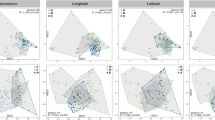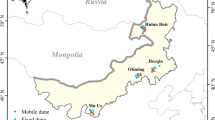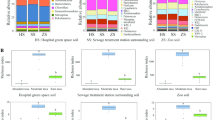Abstract
Unraveling the dynamics and driving forces of abundant and rare bacteria in response to glacial retreat is essential for a deep understanding of their ecological and evolutionary processes. Here, we used Illumina sequencing datasets to investigate ecological abundance, successional dynamics, and the co-occurrence patterns of abundant and rare bacteria associated with different stages of soil development in the Hailuogou Glacier Chronosequence. Abundant taxa exhibited ubiquitous distribution and tight clustering, while rare taxa showed uneven distribution and loose clustering along the successional stages. Both abundant and rare subcommunities were driven by different factors during assembly: the interactions of biotic and edaphic factors were the main driving forces, although less important for rare taxa than for the abundant ones. In particular, the redundancy analysis and structural equation modeling showed that soil organic C, pH, and plant richness primarily affected abundant subcommunities, while soil N and pH were most influential for rare subcommunities. More importantly, variation partitioning showed that edaphic factors exhibited a slightly greater influence on both abundant (7.8%) and rare (4.5%) subcommunities compared to biotic factors. Both abundant and rare bacteria exhibited a more compact network topology at the middle than at the other chronosequence stages. The overlapping nodes mainly belonged to Proteobacteria and Acidobacteria in abundant taxa and Planctomycetia, Sphingobacteriia, and Phycisphaerae in rare taxa. In addition, the network analysis showed that the abundant taxa exhibited closer relationships and more influence on other co-occurrences in the community when compared to rare taxa. These findings collectively reveal divergent co-occurrence patterns and driving forces for abundant and rare subcommunities along a glacier forefield chronosequence in the eastern Tibetan Plateau.







Similar content being viewed by others
References
Banerjee S, Schlaeppi K, van der Heijden MGA (2018) Keystone taxa as drivers of microbiome structure and functioning. Nat Rev Microbiol 16:567–576
Bao Y, Dolfing J, Wang B, Chen R, Huang M, Li Z, Lin X, Feng Y (2019) Bacterial communities involved directly or indirectly in the anaerobic degradation of cellulose. Biol Fertil Soils 55:15
Barberán A, Bates ST, Casamayor EO, Fierer N (2014) Using network analysis to explore co-occurrence patterns in soil microbial communities. ISME J 8:952
Baselga A, Orme CDL (2012) betapart: an R package for the study of beta diversity. Methods Ecol Evol 3:808–812
Blanchet FG, Legendre P, Borcard D (2008) Forward selection of explanatory variables. Ecology 89:2623–2632
Bradley JA, Arndt S, Šabacká M, Benning LG, Barker GL, Blacker JJ, Yallop ML, Wright KE, Bellas CM, Telling J, Tranter M, Anesio AM (2016) Microbial dynamics in a High Arctic glacier forefield: a combined field, laboratory, and modelling approach. Biogeosciences 13:5677–5696
Brown SP, Jumpponen A (2014) Contrasting primary successional trajectories of fungi and bacteria in retreating glacier soils. Mol Ecol 23:481–497
Bulgarelli D, Rott M, Schlaeppi K, Ver Loren van Themaat E, Ahmadinejad N, Assenza F, Rauf P, Huettel B, Reinhardt R, Schmelzer E, Peplies J, Gloeckner FO, Amann R, Eickhorst T, Schulze-Lefert P (2012) Revealing structure and assembly cues for Arabidopsis root-inhabiting bacterial microbiota. Nature 488:91–95
Caporaso JG, Kuczynski J, Stombaugh J, Bittinger K, Bushman FD, Costello EK, Fierer N, Peña AG, Goodrich JK, Gordon JI, Huttley GA, Kelley ST, Knights D, Koenig JE, Ley RE, Lozupone CA, McDonald D, Muegge BD, Pirrung M, Reeder J, Sevinsky JR, Turnbaugh PJ, Walters WA, Widmann J, Yatsunenko T, Zaneveld J, Knight R (2010) QIIME allows analysis of high-throughput community sequencing data. Nat Methods 7:335–336
Carvalho JC, Cardoso P, Gomes P (2012) Determining the relative roles of species replacement and species richness differences in generating beta-diversity patterns. Glob Ecol Biogeogr 21:760–771
Chen YL, Ding JZ, Peng YF, Li F, Yang GB, Liu L, Qin SQ, Fang K, Yang YH (2016) Patterns and drivers of soil microbial communities in Tibetan alpine and global terrestrial ecosystems. J Biogeogr 43:2027–2039
de Sosa LL, Glanville HC, Marshall MR, Schnepf A, Cooper DM, Hill PW, Binley A, Jones DL (2018) Stoichiometric constraints on the microbial processing of carbon with soil depth along a riparian hillslope. Biol Fertil Soils 54:949–963
Deng Y, Jiang YH, Yang Y, He Z, Luo F, Zhou J (2012) Molecular ecological network analyses. BMC Bioinformatics 13:113
Dini-Andreote F, Stegen JC, van Elsas JD, Salles JF (2015) Disentangling mechanisms that mediate the balance between stochastic and deterministic processes in microbial succession. P Natl Acad Sci USA 112:E1326–E1332
Edgar RC (2013) UPARSE: highly accurate OTU sequences from microbial amplicon reads. Nat Methods 10:996–998
Eiler A, Heinrich F, Bertilsson S (2012) Coherent dynamics and association networks among lake bacterioplankton taxa. ISME J 6:330–342
Gobet A, Böer SI, Huse SM, van Beusekom JEE, Quince C, Sogin ML, Boetius A, Ramette A (2011) Diversity and dynamics of rare and of resident bacterial populations in coastal sands. ISME J 6:542–553
Jiang Y, Lei Y, Yang Y, Korpelainen H, Niinemets Ü, Li C (2018) Divergent assemblage patterns and driving forces for bacterial and fungal communities along a glacier forefield chronosequence. Soil Biol Biochem 118:207–216
Jiao S, Chen W, Wei G (2017a) Biogeography and ecological diversity patterns of rare and abundant bacteria in oil-contaminated soils. Mol Ecol 26:5305–5317
Jiao S, Luo Y, Lu M, Xiao X, Lin Y, Chen W, Wei G (2017b) Distinct succession patterns of abundant and rare bacteria in temporal microcosms with pollutants. Environ Pollut 225:497–505
Jones SE, Lennon JT (2010) Dormancy contributes to the maintenance of microbial diversity. Proc Natl Acad Sci USA 107:5881–5886
Kazemi S, Hatam I, Lanoil B (2016) Bacterial community succession in a high-altitude subarctic glacier foreland is a three-stage process. Mol Ecol 25:5557–5567
Kembel SW, Cowan PD, Helmus MR, Cornwell WK, Morlon H, Ackerly DD, Blomberg SP, Webb CO (2010) Picante: R tools for integrating phylogenies and ecology. Bioinformatics 26:1463–1464
Kimes N, Callaghan A, Aktas D, Smith W, Sunner J, Golding B, Drozdowska M, Hazen T, Suflita J, Morris P (2013) Metagenomic analysis and metabolite profiling of deep-sea sediments from the Gulf of Mexico following the Deepwater Horizon oil spill. Front Microbiol 4:50
Knelman JE, Legg TM, O’Neill SP, Washenberger CL, González A, Cleveland CC, Nemergut DR (2012) Bacterial community structure and function change in association with colonizer plants during early primary succession in a glacier forefield. Soil Biol Biochem 46:172–180
Liao J, Cao X, Wang J, Zhao L, Sun J, Jiang D, Huang Y (2017) Similar community assembly mechanisms underlie similar biogeography of rare and abundant bacteria in lakes on Yungui Plateau, China. Limnol Oceanogr 62:723–735
Liu L, Yang J, Yu Z, Wilkinson DM (2015) The biogeography of abundant and rare bacterioplankton in the lakes and reservoirs of China. ISME J 9:2068–2077
Logares R, Audic S, Bass D, Bittner L, Boutte C, Christen R, Claverie JM, Decelle J, Dolan JR, Dunthorn M, Edvardsen B, Gobet A, Kooistra WHCF, Mahé F, Not F, Ogata H, Pawlowski J, Pernice MC, Romac S, Shalchian-Tabrizi K, Simon N, Stoeck T, Santini S, Siano R, Wincker P, Zingone A, Richards TA, de Vargas C, Massana R (2014) Patterns of rare and abundant marine microbial eukaryotes. Curr Biol 24:813–821
Ma B, Wang H, Dsouza M, Lou J, He Y, Dai Z, Brookes PC, Xu J, Gilbert JA (2016) Geographic patterns of co-occurrence network topological features for soil microbiota at continental scale in eastern China. ISME J 10:1891–1901
Miniaci C, Bunge M, Duc L, Edwards I, Bürgmann H, Zeyer J (2007) Effects of pioneering plants on microbial structures and functions in a glacier forefield. Biol Fertil Soils 44:289–297
Mo Y, Zhang W, Yang J, Lin Y, Yu Z, Lin S (2018) Biogeographic patterns of abundant and rare bacterioplankton in three subtropical bays resulting from selective and neutral processes. ISME J 12:2198–2210
Oksanen J, Blanchet FG (2015) Vegan: Community Ecology Package 2.3–0
Pedrós-Alió C (2011) The rare bacterial biosphere. Annu Rev Mar Sci 4:449–466
Qian H, Ricklefs RE, White PS (2005) Beta diversity of angiosperms in temperate floras of eastern Asia and eastern North America. Ecol Lett 8:15–22
Rime T, Hartmann M, Frey B (2016) Potential sources of microbial colonizers in an initial soil ecosystem after retreat of an alpine glacier. ISME J 10:1625–1641
Schloter M, Nannipieri P, Sørensen SJ, van Elsas JD (2018) Microbial indicators for soil quality. Biol Fertil Soils 54:1–10
Schmidt SK, Porazinska D, Concienne BL, Darcy JL, King AJ, Nemergut DR (2016) Biogeochemical stoichiometry reveals P and N limitation across the post-glacial landscape of Denali National Park, Alaska. Ecosystems 19:1164–1177
Schöler A, Jacquiod S, Vestergaard G, Schulz S, Schloter M (2017) Analysis of soil microbial communities based on amplicon sequencing of marker genes. Biol Fertil Soils 53:485–489
Steele JA, Countway PD, Xia L, Vigil PD, Beman JM, Kim DY, Chow CET, Sachdeva R, Jones AC, Schwalbach MS, Rose JM, Hewson I, Patel A, Sun F, Caron DA, Fuhrman JA (2011) Marine bacterial, archaeal and protistan association networks reveal ecological linkages. ISME J 5:1414–1425
Steinberger Y, Zelles L, Bai QY, von Lützow M, Munch JC (1999) Phospholipid fatty acid profiles as indicators for the microbial community structure in soils along a climatic transect in the Judean Desert. Biol Fertil Soils 28:292–300
Sun HY, Wu YH, Zhou J, Bing HJ (2016) Variations of bacterial and fungal communities along a primary successional chronosequence in the Hailuogou glacier retreat area (Gongga Mountain, SW China). J Mt Sci 13:1621–1631
Ulrich W, Almeida-Neto M, Gotelli NJ (2009) A consumer's guide to nestedness analysis. Oikos 118:3–17
Vestergaard G, Schulz S, Schöler A, Schloter M (2017) Making big data smart—how to use metagenomics to understand soil quality. Biol Fertil Soils 53:479–484
Wang J, Wu Y, Zhou J, Bing H, Sun H (2016) Carbon demand drives microbial mineralization of organic phosphorus during the early stage of soil development. Biol Fertil Soils 52:825–839
Wang S, Wang X, Han X, Deng Y (2018) Higher precipitation strengthens the microbial interactions in semi-arid grassland soils. Glob Ecol Biogeogr 27:570–580
Wu W, Logares R, Huang B, Hsieh CH (2017) Abundant and rare picoeukaryotic subcommunities present contrasting patterns in the epipelagic waters of marginal seas in the northwestern Pacific Ocean. Environ Microbiol 19:287–300
Xue Y, Chen H, Yang JR, Liu M, Huang B, Yang J (2018) Distinct patterns and processes of abundant and rare eukaryotic plankton communities following a reservoir cyanobacterial bloom. ISME J 12:2263–2277
Yan W, Ma H, Shi G, Li Y, Sun B, Xiao X, Zhang Y (2017) Independent shifts of abundant and rare bacterial populations across east Antarctica Glacial Foreland. Front Microbiol 8:1534
Zhang B, Zhang J, Liu Y, Shi P, Wei G (2018) Co-occurrence patterns of soybean rhizosphere microbiome at a continental scale. Soil Biol Biochem 118:178–186
Zumsteg A, Luster J, Göransson H, Smittenberg RH, Brunner I, Bernasconi SM, Zeyer J, Frey B (2012) Bacterial, archaeal and fungal succession in the forefield of a receding glacier. Microb Ecol 63:552–564
Acknowledgements
The authors are grateful to the Gongga Mountain Alpine Ecosystem Observation Station, Chinese Academy of Sciences for logistic support. This work was supported by the Talent Program of the Hangzhou Normal University (2016QDL020).
Author information
Authors and Affiliations
Corresponding author
Additional information
Publisher’s note
Springer Nature remains neutral with regard to jurisdictional claims in published maps and institutional affiliations.
Electronic supplementary material
ESM 1
(DOCX 1248 kb)
Rights and permissions
About this article
Cite this article
Jiang, Y., Song, H., Lei, Y. et al. Distinct co-occurrence patterns and driving forces of rare and abundant bacterial subcommunities following a glacial retreat in the eastern Tibetan Plateau. Biol Fertil Soils 55, 351–364 (2019). https://doi.org/10.1007/s00374-019-01355-w
Received:
Revised:
Accepted:
Published:
Issue Date:
DOI: https://doi.org/10.1007/s00374-019-01355-w




